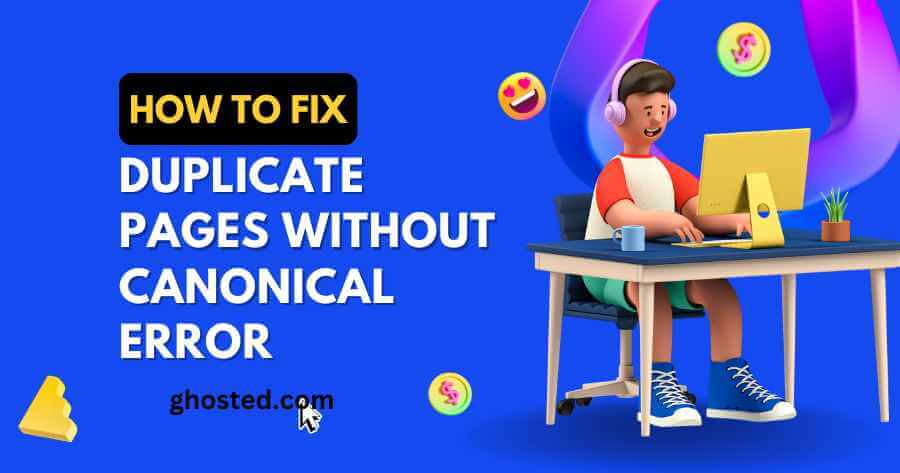When your Search Console Page Indexing Report displays “Duplicate Pages Without Canonical Error,” that indicates Google found duplicate content but couldn’t ascertain which page version should take priority – potentially leading to issues for both SEO and user experience.
Canonical tags are an SEO best practice that helps Google determine the most significant pages. But there are other strategies available to you for dealing with this issue.
Table of Contents
Toggle1. Diversify Your Content
Duplicate pages can have a devastating effect on your SEO, degrading text relevance and draining search engines’ crawl budget as they decide which version to index. They can also lead to duplicated content citations which can cause penalties or removal from search results altogether.
At least, fixing “Duplicate Pages Without Canonical Error” errors is generally straightforward. First, identify which pages have this issue by reviewing page indexing reports in Google Search Console or in Rank Math’s Index Status tab. Next, review their URLs to identify which version is preferred before adding canonical tags on preferred versions so search engines know which version should be prioritized for indexing and ranking purposes.
Websites with multiple languages or locations require canonical tags to make their pages index correctly; otherwise it becomes increasingly challenging to keep track of all of the different versions of a single page of content. For example, if your product/service information for sale in American spelling is published to one market (say the U.S. market) while another page featuring same information in British spelling appears elsewhere (say for instance in U.K. market), using canonical tags will ensure that only U.K. page gets indexed instead of the American version
2. Add Self-Referenced Canonical Tags
Google avoids indexing duplicate content to conserve resources, choosing one version of your page over its other variants and ignoring all others. Unfortunately, this can lead to keyword cannibalization where different versions compete against one another for search rankings, thus harming search rankings unless canonical tags are correctly applied.
Canonical tags help search engines better comprehend your website’s structure and identify which variant of a page should be preferred by Google. When used correctly, canonical tags can help avoid duplicate pages being indexed by Google and prevent keyword cannibalization; however, due to duplicate content issues with URL parameters, this may prove challenging.
Error code ‘Duplicate Without User-Selected Canonical’ in Ahrefs Site Audit indicates that Google hasn’t identified a canonical page for these multiple pages – either due to content duplication or improper implementation of canonical tags.
One way to combat this problem is by adding self-referential canonical tags, which point directly to each page’s URL instead of another on your site. You can add these tags in the head section of web pages so Google focuses on only ranking pages that should rank.
3. Remove Duplicate Pages
Ahrefs’ Site Audit displays an error message called Duplicate Pages Without Canonical to indicate that Google is recognizing duplicate content on your website. While this isn’t necessarily bad news, correcting it can be challenging since it appears as though Google doesn’t choose just one version to index – instead choosing canonical variants that might not meet your desired criteria for indexation.
Sometimes this may be a technical issue with your CMS or website template. For instance, selling multiple variations of one product (with different colors or sizes) will likely result in numerous URLs with identical or nearly identical content that should not be duplicated and should use canonical tags to ensure that their preferred page is the one indexed by search engines.
To address this problem, remove duplicate pages from your website and ensure their corresponding URLs do not appear in your XML sitemap. Also set a canonical tag or use canonical redirects (301 redirects in some cases) so your indexed pages won’t compete against each other and negatively impact search engine rankings.
4. Contact Hireseo.net
Duplicate pages without Canonical error is a common SEO problem that can be fixed easily in just a few steps. By diversifying page content and applying canonical tags consistently with other signals and eliminating duplicate URLs, this status or error in Google Search Console will no longer persist.
Canonical tags can help consolidate link signals for similar or duplicate content and optimize crawling budgets by telling Google which version of a page should be considered the “original.” However, if your rel=canonical attribute has indicated your preferred URL but Google still indexes other pages with similar content that it should rank instead, resources may be wasted trying to rank those other pages instead of your preferred one.
To address this problem, consult Google Search Console‘s Not Indexed report or the Index Status tab of Rank Math’s tool and identify all duplicate pages being indexed; add canonical tags to each version; recrawl your website until Google recognizes these new canonicals; reindex your pages once more if needed; wait a week and repeat this process if needed.
Atif Ali is a senior digital marketing specialist at Hireseo, an international SEO agency with offices in Poland and the US. With his varied skill set and dedication to quality client care, Michal works tirelessly to guarantee top quality for his clients. In his free time he loves traveling and watching sports events.




